
|
Mosses
First posted July 7, 2004 Last updated July 7, 2004
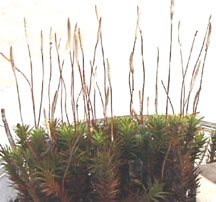

|
Introduction
The first group of plants that took advantage
of the new territory, land, were the mosses
and their allies, the liverworts and hornworts.
Together, they are called the bryophytes.
They are land plants, but do not have a vascular
system (xylem and phloem), seeds, or flowers.
The other land plants are the ferns
and their allies (horsetails, whisk ferns),
which have spores and a vascular system; conifers,
which have a vascular system as well as seeds
but no flowers; and flowering plants,
which have a vascular system as well as seeds
and flowers. Let's see how the mosses are different
from the other land plants, as well as from
lichens (a mutualistic association of a fungus
and an algae and/or a bluegreen bacteria).
|
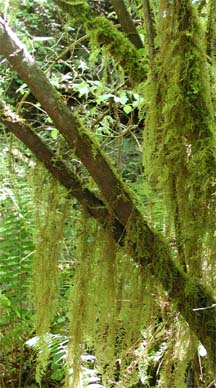
Moss growing along a small creek
that flows
into Austin Creek, just above camp |

Two Worlds
| Land plants have a problem that aquatic photosynthetic
organisms (such as algae) don't have: they live
in two worlds. They live in the world of soil,
where they get their water and nutrients. But
they also live in the world of air, where they
get their sunlight and carbon dioxide. These two
worlds are very different, and in fact are almost
opposites. The world of soil has no sunlight,
but lots of water. The world of air has lots of
sunlight, which tends to dry up all the water
as well as dry up the plant. Land plants had to
develop means of coping with these two opposites,
as well as connecting them. If you are the plant,
having water in your roots does not help you much
if you cannot transport it to the leaves which
have the sunlight for photosynthesis; making sugars
in the leaves do not do you much good if you cannot
transport them to the root for storage. Land plants
eventually solved this problem by developing structures
such as roots, leaves, a stem to connect them,
and a vascular system to transport nutrients,
water, and metabolic products such as sugars and
hormones. |
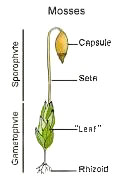 |
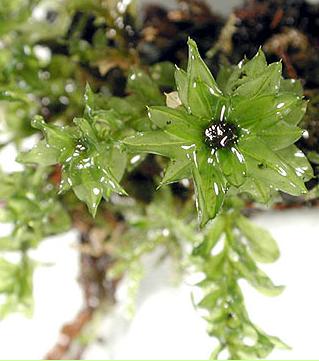 |
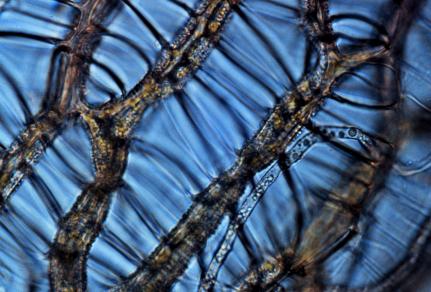 |
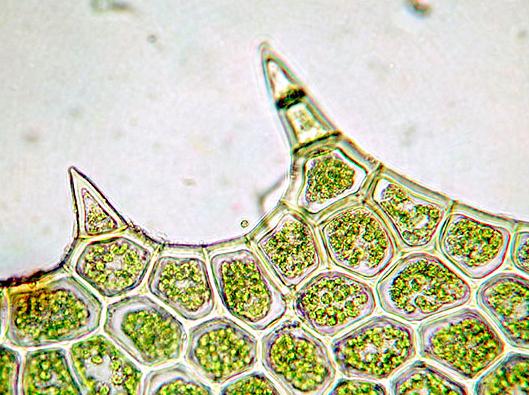 |
"leaves" of moss |
cells in the "leaf" |
another view of "leaf"
cells |
The first land plants, however, did not have these
systems. Mosses started the march onto the land
by developing primitive systems to deal with the
problems of living on land, but do not have fully
developed roots, leaves, stems, and a vascular system.
Mosses absorb their water and nutrients directly
into their bodies, not through their "roots".
Instead of roots, they have rhizoids, which serve
to stabilize the moss but do not have a primary
function in water and nutrient absorption. They
lack a vascular system both in their rhizoids and
in their above-ground parts. They also lack lignin,
which is a complex compound that stiffens the stems
of higher land plants. This is why mosses are so
soft. Their "leaves" are actually single-cell
thick leaf-like appendages. True leaves have several
layers of specialized tissues. The lack of vascular
tissue forces mosses to be rather short, because
they cannot transport water, nutrients, and metabolic
products.
Mosses do have a property that vascular plants
do not have: they can dry out and still come back
to life. Lacking roots, and therefore a ready way
to obtain water all the time, mosses had to adapt
to a feast or famine approach to water. Mosses can
dry out to a remarkable degree, yet spring back
to life with just a single sprinkling of water (this
is rather fun to do when you see dryed out moss
on a hike). Higher plants would die with a similar
degree of desiccation.

Alternation of Generations
All plants have an alteration
of generations. The two generations are called
the sporophyte generation (generates the spores)
and the gametophyte generation (generates the
gametes, the egg and sperm). In mosses, the
gametophyte generation is the larger, more easily
seen generation. It is the leafy, green part
that we think of as a moss. It produces the
gametes, the egg and the sperm, which create
the sporophyte generation.
The sporophyte generation has three parts,
the foot, the seta, which is the small, usually
brown slender stalk (see illustration at right)
that sticks up beyond the green, leafy moss,
and the capsule, which is a bulb at the tip
of the seta. The capsule contains the sporangium,
which contains the spores.
For a great illustrated explanation of the
life cycle of a moss, see the University
of Auckland, New Zealand, website. |
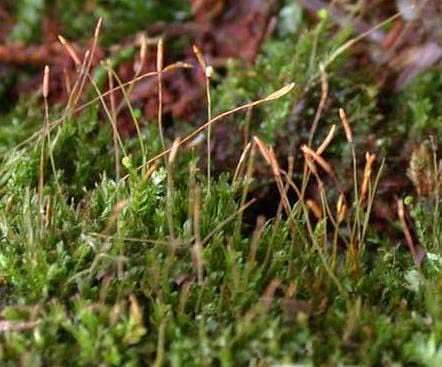 |
Mosses, then, are land plants without
a vascular system, seeds, or flowers, with a dominant
gametophyte generation.

The SIU
webpage on moss is a lot of fun.
The University
of British Columbia Biology 321 website
is wonderful and a source of many of the above illustrations.
The University
of New Zealand website has a large collection
of photos of mosses and their life cycle.

Acknowledgements
This section is largely based on the excellent book
Biology,
by Campbell and Reece. It is a college
text for beginning biology students. I cannot recommend
it highly enough. If it has been a few years (!) since
you have had biology, you will not believe how much
things have changed. Not only is there a lot more known
about biology, the presentation of the material is vastly
improved. From text that is closer to literature than
dry explanation, to color illustrations and color photographs
that are so widely used, I doubt that in its entire
1240 pages, there are any without at least three or
more color graphics of some sort. And that does not
even begin to explore the enclosed CD or associated
online material. I will eat my hat if you don't love
the book. I bought mine online, at Amazon.com.
The photographs of the moss with sporangia
are from the University
of Manitoba biological sciences webpage
and from the University
of British Columbia botany webpage.
|

|

